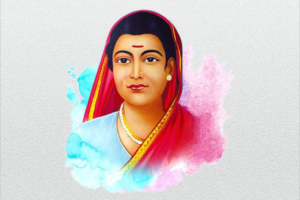Krantijyoti Savitribai Phule
Bharat, this great motherland of ours, has been blessed with many personalities who were no less than an incarnation of gods. Among the long list of such personalities, there are many women whose work is of such great nature that no one can avoid. Savitribai Phule is one such personality that our mainstream historians tend to ignore. A pioneer of women’s education in India and the first headmistress of India is remembered as the wife of a great social reformer, Mahatma Jyotirao Phule. But she is way more than that.

Savitribai was born on 3 January 1831 at Naigaon village in today’s Satara district of Maharashtra. Her father’s name was Khandoji Newase, and her mother’s name was Lakshmi. Following the societal norms prevailing in that period, she was married at 9 to Jyotirao Phule, the most significant social reformer who ever lived. Jyotirao Phule was just 11 at that time. As there was no permission for women to educate themselves, Savitribai was not formally educated at any school. Jyotirao Phule had completed his education at Scottish missionary schools. When Jyotiba decided to open schools for women, he immediately felt the need to educate Savitribai.
Opening schools for Women was no less than waging war against society, as society was strictly against girls’ education. Savitribai even faced problems while finding a suitable place to educate women. As upper caste people were reluctant to send their children to their schools, Savitribai and Jyotiba Phule invoked untouchable castes like Mahar and Mang to send them to school. The resistance from the upper caste was so intense that while going to school, people on the streets used to throw mud, stones, and Cowdung at Savitribai. It is said that she used to carry two sarees with her due to this attitude toward society. According to the memoirs by Balwant Sakharam Kolhe, Savitribai would say to those who troubled her, ‘As I do the sacred task of teaching my fellow sisters, the stones or cow dung that you throw seem like flowers to me. May God bless you!’ These memories of Balwant Sakharam Kolhe shed light on Savitribai’s s immense courage. Not paying attention to what is coming from society, she and Jyotiba kept doing their work. By 1851 they had opened three schools to educate Dalits and women.
Savitribai had also taken teacher‘s training at Ms. Farar’s Institution at Ahmednagar and the Normal School of Ms. Mitchell in Pune. Savitribai would work with Jyotirao in a Scottish missionary school. It is said that they were so passionate about their work that they would forget to take their meal. Jyotirao-Savitribai started two institutions- Native Female School, Pune, and the Society for Promoting the Education of Mahars and Mangs. They built a network of schools in the Pune region through these two institutions. Some scholars feel that Jyotirao-Savitribai started their educational work in 1851, but this does not seem accurate. They had started this work in 1848, as proved by both the newspapers- Dnyanodaya and Bombay Guardian.
Jyotirao and Savitribai focused on providing girls and boys with vocational and trade-oriented education to make their students self-reliant and capable of independent thought. In the 1852 report, they expressed the following:’ An Industrial department should be attached to the schools where children could learn useful trades and crafts and be able, after leaving school, to manage their lives comfortably and independently.’ They created such a system.
After receiving an education from her husband Jyotirao she utilized it in every aspect of her life. She also tried her hand at writing poetry. In 1854 she published her collection of poems called ‘Kavyaphule, ‘and in 1892, she wrote another one called’ Bavanskashi Subodh Ratnakar.’ After the establishment of Satyashodhak Samaj, Jyotirao actively participated in every activity of the institution. She fought against the tradition of removing all hair of the widows, which was prevalent in society. According to this tradition, a widow was asked to stay bald for the rest of her life. She also made barbers go on strike as a tool of resistance against this tradition. She also fought against the dowry tradition. Even today, we still hear news like a woman is burnt alive, divorced, or sent back to her parent’s home just because she couldn’t give enough money as a dowry. In addition to this, she also fought against the inhuman sati tradition. Phule later opened a women’s shelter called the Home for the Prevention of Infanticide, where widows could deliver their children and leave them for adoption.
It was the time of the bubonic plague in India. British officer Rand was in charge of this mission of handling this bubonic plague. Savitribai had settled a hospital on Pune’s outskirts to cure the plague’s patients. As soon as she learned that the son of Pandurang Babaji Gaekwad in the Mahar settlement outside the village of Mundhwa was afflicted with the plague, she went there and rushed back to the hospital with the sick child on her back. She caught the disease in this process, and on 10 March 1897, she passed away. Deenbandhu reported the news of her death with great grief and regret. Those who praise the heroic act of Rani Laxmibai of fighting the enemy with her son strapped onto her back, however, have completely ignored the heroism of this woman who saved a sick child, carrying him on her back.
Rushikesh Bhalerao
References:
1. https://artsandculture.google.com/story/savitribai-phule-ubaan/mAWBW6eHcTWSLg?hl=en
2. https://www.indiatoday.in/information/story/savitribai-phule-jayanti-2022-lady-behind-the-importance-of-women-education-in-india-1895384-2022-01-03
3. https://www.amarujala.com/shakti/savitribai-phule-birth-anniversary-she-became-indias-first-female-teacher-know-interesting-facts-about-her
4. https://www.jetir.org/papers/JETIR1907P04.pdf
5. https://www.sbibengalcouncil.com/Savitribai%20Phule.pdf
